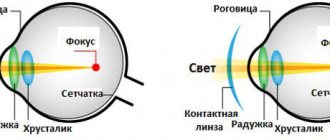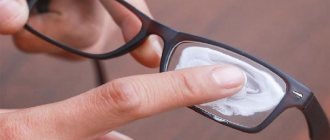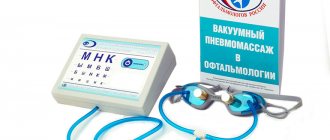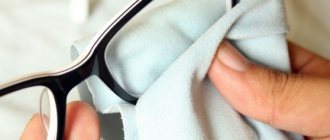Myopia is a very common disease that affects many children and adults. If you think about it, in every class and group there is a person with glasses: is he nearsighted or farsighted is another question, but still we often have to deal with this disease. And for people whose vision has fallen, but not too much, the question naturally arises: is it necessary to wear glasses for weak myopia? It would be a good idea (and necessary) to understand this issue better before making a final decision. It is also worth noting that the final word in any case should remain with the doctor.
How does the eye see with myopia?
With normal vision, rays of light emanating from objects pass through the cornea and transparent media of the eye, are refracted in it and clearly focused on the retina. Ideally, when viewing distant objects, the eye muscles should be relaxed and the lens should be flattened. When you need to see something close, the muscles tense, causing the lens to become convex to the desired extent. The image is refracted by the lens to accurately focus on the retina.
With myopia (myopia), the lens is constantly curved, so far away objects do not come into focus and onto the retina. The rays emanating from the object are focused not on the retina, but in front of it, so the projection of the image reaches the light-receiving shell blurred. The outlines of distant objects are unclear.
Spectacle correction of myopia in children and adults
The power of refraction of light, that is, the optical power of the lens, is measured in diopters. One diopter is equal to 1 m of the focal length of the lens. It is at this distance that a clear image is normally obtained.
The number of diopters is the degree of curvature of the lens. The range of changes in the optical power of a healthy person’s eye is
14 dioptres. With age, this figure decreases. For distance vision, the diopters need to be reduced, so glasses for myopia have a minus. With hypermetrometic diopters, the curvature of the lens must be added, so glasses are taken with a plus.
When is it necessary to wear optical devices for myopia?
Wearing glasses becomes necessary for myopia of 1 D, but this does not need to be done all the time, only when necessary. People with severe myopia should wear glasses at all times.
If a person’s work involves viewing objects closer than 40 cm, glasses can be removed. Ideally, it is better to have several pairs: for regular use, for reading and writing. You need to have them with you and use them for a specific occasion.
Hereditary myopia
Hereditary myopia is the most common form. And so much so that when diagnosing a pathology, it is precisely this that is implied. It is also important that the degree of myopia is inherited. The first and second degrees are transmitted as an autosomal dominant trait. This means that the mutant gene is located in one of the autosomes (non-sex chromosomes) and is dominant. It will appear in all generations. High - due to an autosomal recessive trait.
If there is only one myopic parent in a family, the risk of the disease in children will be 50-100%. When both are myopic, the probability will be 75-100%, but the child may remain only a carrier of the gene, that is, the descendants will receive the gene, but the parent will not get sick. If both parents have an asymptomatic gene, 25% of their children will be myopic, moreover, to the 3rd degree.
Most likely, wearing glasses for hereditary myopia will be necessary from childhood - from 2-3 years. At a high degree they will become permanent. This measure is necessary to avoid the progression of the pathology.
Physiological and congenital
The physiological form of myopia can occur between the ages of 5 and 10 years. The fact is that during this period eye growth is accelerated. If for various reasons the eyeball becomes too large in its anteroposterior size, myopia develops. Usually, towards the end of puberty, the growth of the eyeballs slows down and stops, and then the degree of myopia decreases.
Congenital myopia most often occurs in premature babies. By about 9 months, these babies' eyes take on a natural shape. Otherwise, we will be talking about pathological myopia.
False myopia
Myopia can be true (anatomical) or false. With true, there are problems with the refractive system or the shape of the eyes. Anatomical myopia usually increases with age. Eyepieces become a permanent fixture. This is the only way to improve vision.
False myopia is a spasm of accommodation of the eye. The refraction here is normal, there is only a functional impairment. A person can see well at different distances.
As a result of prolonged work at the computer or reading, the ciliary muscle remains in a tense state for a long time, and pathological changes occur in it. If a person now tries to look into the distance, the ciliary muscle does not relax, but remains tense.
In such conditions, the lens seems to be stuck in a curvature and its shape is not corrected. For this reason, distant vision appears blurry. This goes away with rest or relaxing eye exercises.
There is no need for glasses for false myopia; moreover, it is harmful. Here it is necessary to awaken the eye muscles, for example, by instilling special eye drops. If no measures are taken, this will result in true myopia.
Acquired myopia
If a genetic factor is excluded, acquired myopia is diagnosed; its causes can be:
- Lack of visual hygiene - increased constant visual stress. You can reduce their negative impact with relaxing eye exercises, taking vitamins, and proper nutrition. However, few people do this. Even the basic rules for working at a computer are not observed: distance from the monitor, breaks in work, relaxing exercises, etc. People do not think about the fact that myopia cannot be cured, but only corrected.
- Vitamin deficiency - the risk of pathology increases with a lack of vitamin B2 and A. Twilight vision worsens (so-called night blindness), the eyes become asthenic and quickly tire.
- The primary weakness of the accommodative apparatus is the weakening of the ability to move the gaze from one object to another. The lens or cornea has insufficient refractive power. The image is formed behind the retina.
- An increase in the diameter of the eyeball - while the body tries to compensate for the defect. Accommodation goes away, but myopia appears.
- Eye injuries – with damage to the refractive media of the eye.
Night
Night myopia is not a pathology. It also occurs in healthy people, but is not given any importance. When entering a dark room, the pupils become wider. The lens bends quite strongly and the focus is in front of the retina. You don't need glasses. Night myopia is the body’s defense against deteriorating lighting levels.
Progressive
With progressive myopia, vision deteriorates rapidly - by 1 or more diopters per year. With this form, you need to wear glasses all the time, otherwise your vision will deteriorate further. Correction with glasses does not cure the pathology, but stops its development.
The need to wear corrective glasses for varying degrees of myopia
The need to wear glasses is determined by the degree of myopia detected:
- Weak degree – from -0.25 to -3.0 D. Up to a value of –1D, wearing glasses is not necessary, because the patient does not experience any particular inconvenience. You just need to properly organize your workplace and lighting, and avoid visual overload. In this case, regular exercise helps. Correction with glasses at an early stage is required when visual acuity is from −1 to −3 diopters. But glasses will only be needed for distance vision.
- Average – from -3.25 to -6.0 D. With an optical power value of –5 D, objects are poorly visible even at a distance of 25-30 cm from the face. In addition, changes occur in the fundus of the eye in the form of narrowing of the retinal vessels and its initial dystrophic disorders. Such patients should visit an ophthalmologist every 6 months. Glasses for degree 2 myopia are always needed. Usually 2 pairs or a bifocal model are prescribed: the upper part of the lens for distance, the lower for near. This is convenient for any type of vision.
- High degree - from -6.25 D and above. A person sees objects far and near poorly; objects are not visible even at a distance of 10 cm. Of course, in these cases the glasses are permanent. Constant monitoring by an ophthalmologist is necessary. Many patients with such disorders do not want to wear glasses: the lenses are too strong and thick, they narrow peripheral vision, and objects are distorted and made smaller. In such cases, glasses may simply not be enough; surgery, laser surgery, or lenses are required.
Myopia: what is it?
Myopia - or, as it is also called, myopia - is a disease based on a vision defect. A nearsighted person sees well near, but poorly at distance. This phenomenon is most often caused by a change in the shape of the eyeball.
There is also the opposite option, which is called farsightedness , and regarding it the question of the need to wear eyepieces also arises quite early.
low degrees of myopia (up to -3 diopters; normally a person sees 1), medium (from -3.25 to -6) and high (over -6). It is worth noting that high myopia can be quite scary: up to -15 and -20, and sometimes -30 diopters.
Myopia is also divided into congenital and acquired . Acquired myopia, contrary to popular myths, occurs in children who do not sit in front of a computer/TV, but read books, and even then, such a load has the least impact on the progression of myopia. Myopia itself most often progresses independently.
Well, eyepieces are a way not to treat, but to help myopic people . Reconstructive surgery may be considered treatment. Glasses and lenses are an analogue of a crutch.
But when eyepieces for myopia first began to appear, a myth associated with them also appeared. Thus, some people argued that for mild myopia, glasses only “relax” the muscles of the eye, which leads to worsening vision, and recommended that people give up eyepieces if possible. Well, it’s worth considering in detail all the arguments for and against wearing eyepieces for mild myopia.
How eyepieces are selected
The selection and prescription of glasses is carried out only by a doctor after examination. You can’t buy at random or wear neighbor’s ones. In such cases, a person runs the risk of damaging his vision even more, which is why it is so important to establish the degree, etiology and form. The selection of optics depends on these indicators. For adults, lenses are selected according to parameters corresponding to visual acuity.
The optometrist must adhere to certain principles:
- The degree of pathology is determined separately for each eye, at rest and movement.
- Correction should be carried out taking into account binocular vision.
- If myopia is up to -6.0 D, near vision should be restored to the maximum
- For myopia of more than 6 diopters, the ophthalmologist usually recommends 2 pairs of glasses - for near vision and distant vision.
When selecting glasses, the doctor determines the presence of myopia by placing diverging lenses in front of the patient. The choice begins with weak lenses, with the gradual application of stronger ones. This procedure is familiar to many. On some lens, vision is 100%.
“Plus” glasses for myopia
Usually, for myopia, minus glasses are indicated, but it is possible that plus glasses are also prescribed. Many ophthalmologists believe that the benefits force the body to fight myopia on its own. This is especially true for children. At the same time, the natural forces of the body are activated. In addition, plus ones help relieve spasm of accommodation.
"Minus" lenses
Ophthalmologist of the highest category. Candidate of Medical Sciences.
Treatment of myopia with glasses
Treatment of myopia is possible with two types of glasses:
- traditional (with negative diopters);
- positive ones.
“Plus” glasses for myopia
Especially often, “plus” glasses were used in the past to correct vision defects. And now the fashion is returning again, since ophthalmologists believe that the use of positive diopters forces the body to fight myopia on its own.
Advice! Treatment of primary myopia in children is often carried out using glasses with positive optical power.
"Minus" lenses
Traditional glasses with negative diopters help a person to see distant objects clearly and clearly. You should always wear such glasses if there is a need to see the situation in the distance, since they provide one hundred percent visibility. But when working close (reading, writing texts), it is advisable to remove them.
This almost always involves certain inconveniences. It is for such situations that the use of bifocal glasses is provided. The lens is divided into two parts:
- for convenience of working at close range (lower lobe);
- to improve the visibility of distant objects (upper lobe),
The lower part of the lens always has a weaker optical power, usually by 1-3 diopters. Using such glasses solves many problems.
Choosing eyepieces: some subtleties
The degree of visual deviation from the norm is determined by a specialist. He writes out the prescription, but everything else (lens material and frame type) is chosen by the patient according to his preferences. Constant wearing of glasses is necessary only for degrees 2 and 3 myopia. Competent correction can improve the patient’s vision and prevent its deterioration.
Lenses
There are two types of lenses:
- Made of mineral glass - they are highly resistant and perfectly transparent, they have stronger optical properties, protect the eyes from UV rays, but they are heavy and thick. The downside is that they fight and create a danger. Such glasses, for example, are not recommended for professional athletes.
- Plastic ones are the most modern. The advantage of such lenses is lightness and strength. Disadvantages - short service life due to rapid rubbing with small scratches, insufficient optical power - less diopters. Therefore, compensation of the visual defect is not always possible to the full extent.
The surface can be: colorless transparent, painted in a certain color and photochromic (chameleons).
The coating can be anti-reflective. Such glasses filter out light streams, leaving only the safe spectrum - yellow). For computer work, there are glasses with a protective coating to quickly defog the lenses.
The surface shape of the lenses for myopia is diverging, and they are thicker at the edges. There are 3 types: flat, convex, and biconcave lenses. The thickness at the edges directly depends on the degree of myopia.
Frame selection
The following types of frames exist:
The stage of myopia also determines the type.
The advantages of plastic frames are their lightness, they do not put pressure on the bridge of the nose, do not react to external temperature, are comfortable, but short-lived.
Metal frames are more reliable, suitable for thick glasses, but they are heavy and oxidize over time.
The “2 in 1” option is a metal frame around the glass with plastic temples. Lenses for small visual deviations are quite thin. They need a metal frame. At the same time, the metal does not bear a large load on the bridge of the nose.
The absence of a frame will be justified in cases of second degree myopia; here thicker lenses are needed and the metal will make the structure heavier.
For grade 3 myopia, it is advisable to purchase plastic frames.
Memo to the patient: sequence of actions when choosing glasses
First, the patient should visit an ophthalmologist.
To select glasses, the doctor must:
- identify the cause of myopia;
- set the level and degree of myopia for each eye;
- determine the level of correction in diopters;
- identify concomitant diseases and astigmatism;
- measure the center value of the glass and select a frame;
- determine the complexity of the lens.
- For high myopia, it is desirable to have a wide frame so that heavy lenses are securely fixed in it and their thick edge is closed.
- For low diopters, the frame is better without a rim or half of it.
How to choose glasses for myopia
To make the right choice, lenses and frames are assessed against a variety of criteria. Lenses are usually distinguished by:
- material - thin and light plastic with a small number of diopters or glass, thicker and heavier, but with more pronounced optical properties,
- coating - protective, anti-glare, for working at a computer, etc.,
- shape - flat-concave, convex-concave and biconcave.
When choosing frames, it is important to decide on the material from which it will be made. It could be:
- plastic: lightweight, poorly responsive to temperature changes, comfortable, but rather fragile,
- metal: reliable and wear-resistant, but heavier,
- “two in one” option: metal frame around the glasses and plastic arms.
Wrong glasses
When glasses don't fit, irreversible consequences can occur. A new type of optics always causes discomfort during the first week. During the adaptation period, blurred images and poor concentration are possible. There may be slight disorientation in space.
Symptoms
The main signs of incorrect selection of optics:
- Constant discomfort - my eyes hurt, I want to take off my glasses.
- Migraines appear, blood pressure rises and insomnia occurs.
- The eyes constantly get tired quickly, dizziness and nausea bother them, performance decreases and the degree of myopia increases.
These manifestations should not cause concern in the first 7 days after purchase. Otherwise, you will need to retest your vision and replace your lenses.
What happens if you choose the wrong eyepieces?
Incorrect eyeglass lens values can negatively impact your eye health. The consequences of wearing such glasses will appear quite quickly: inflammation of the eyes, development of strabismus, increasing deterioration of vision.
Useful video
At what age can you wear contact lenses?
Does a child with myopia need to wear glasses all the time?
Myopia can appear in children very early, even at 2-3 years of age. Many parents are concerned about whether such young patients can wear glasses. For myopia, correction means help stop its development and improve a person’s quality of life by compensating for refractive error. Let's learn how to choose optics and how to wear them correctly.
In this article
Do I need to wear glasses all the time?
Doctors are often asked: do glasses damage your vision if you wear them without taking them off? The answer to this question is individual for each patient and depends on the degree of neglect of the disease. At the initial stage, they are needed only during visual stress, for example, when watching TV or working at the computer. But with progressive myopia, this rule ceases to apply - for such patients, the answer to the question of whether it is necessary to constantly wear glasses for myopia can only be affirmative.
To avoid excessive tension of the eye muscles, in case of a significant decrease in visual acuity, it is recommended to use 2 models simultaneously - for constant wear and, for example, for reading or writing.
Mechanism of development of myopia
In ophthalmology, nearsightedness is called myopia. This concept refers to a refractive error in which the image is formed not on the retina, but in front of it. This results in poor distance vision. The development of myopia leads to a reduction in the distance from which a person sees objects clearly. This can eventually cause complete loss of vision. There are three main causes of myopia:
- abnormal structure and development of the eyeballs;
- damage to the refractive system of the eyes;
- poor visual hygiene.
The structure of the eye and the development of myopia
The eyeball is a complex structure that ensures the formation of an image on the retina and its subsequent transmission to the brain. Moreover, each structural unit in the eye is responsible for performing certain functions. In total, there are three main parts of the eyeball:
1. The outer shell with the sclera and cornea, which is a transparent hemisphere curved outward. The cornea, due to its shape and transparency, ensures the unhindered passage of light rays through it. 2. The choroid, responsible for the blood supply to the eye. All its tissues receive nutrition along with oxygen delivered through the blood. The choroid (uveal tract) also includes the iris and ciliary body. They regulate the amount of light entering the eye. The muscles of the iris contract depending on the intensity of light. If the light is too bright, the pupil constricts. Thanks to this, less light rays enter the eyeball. When a person is in a room with poor lighting, the pupil, on the contrary, dilates so that more light enters the eye. 3. The inner shell, or retina, which consists of a huge number of photoreceptors - light-sensitive cells. They convert light rays into nerve impulses that enter the cerebral cortex.
The main roles in the refraction of rays are played by the cornea and the lens - a natural biconvex transparent lens with increased elasticity and the ability to change its shape. The refractive power of the cornea remains unchanged. Normally it is equal to 40 diopters. This indicator for the lens can be different - from 19 to 33D. The refractive power changes when the lens changes its shape, that is, when it bends. This occurs when the gaze is shifted from objects near a person to distant objects and vice versa. All of the listed ocular structures are involved in ensuring high-quality vision. Equally important are the extraocular muscles responsible for focusing.
As noted earlier, there are three main causes of myopia.
The first is associated with the irregular shape of the eyeballs, their diameter is too large. The second reason is damage to the refractive system or its individual components, mainly the cornea or lens. The third factor is poor visual hygiene, which causes weakening of the extraocular muscles.
All these reasons lead to improper functioning of the eye. After refraction, light rays end up not on the retina, but in the plane in front of it. To reduce refractive power, diverging, concave lenses are required. For this reason, glasses with negative (“minus”) diopters are prescribed for myopia. Such optical products move the image to the center of the retina.
Do I need to wear glasses all the time if I am nearsighted? Why do some people only use them when driving and watching TV, while others have to put their glasses on in the morning and only take them off before going to bed? This depends on the degree of vision pathology and other factors.
How to wear glasses for myopia? Degrees of pathology
Glasses for constant wear for myopia are prescribed only for complex forms of this pathology. It goes through several stages of development. They are called degrees. The first (weak) is characterized by a vision index from −0.25 to −3D. At this stage, you do not always need to wear glasses. It is necessary to drive a car only with optics on, as distant objects appear blurry, which can be dangerous. But the rest of the time you can do without her help.
The second, average, degree is a visual deviation from −3.25 to −6.0D. With such indicators, you will need to wear glasses constantly. A person may not be able to distinguish the facial features of his interlocutor. In addition, with such a state of vision, it will be quite difficult to navigate in space without correction means.
A high degree of myopia (strong) is diagnosed with a deviation of −6.25D or higher. Such patients may be prescribed two pairs of glasses: for constant wear and for reading. In severe forms of myopia, the patient may see practically nothing at a distance of 10 cm from the eyes. It is impossible to do without correction means.
Degrees are not all the factors that influence the method of correcting myopia. Much depends on the patient’s age, individual physiological characteristics, and the type of pathology that is determined by the causes of the disease. Let's try to figure out whether a child needs to wear glasses, at what age optics are prescribed to children and in what mode they should be used.
Types of myopia
There are many predisposing factors that lead to the occurrence of this pathology. Its shape and method of correction depend on them. Thus, with damage to the refractive system, in particular, an increase in the refractive power of the lens, lenticular myopia develops. This often happens with diabetes. If the shape of the eyeballs is irregular and their size is larger than normal (24 mm), axial myopia is diagnosed. There are other varieties of this disease: congenital, acquired, nocturnal, physiological, false, hereditary. Not every form of myopia requires wearing glasses.
Do you need glasses for false myopia?
Myopia can be true or false. In the first case, we are talking, in fact, about a pathological condition of vision, when a person has difficulty seeing into the distance due to problems with the refractive system or the shape of the eyes. This type of defect must be treated, otherwise it progresses, and visual functions deteriorate more and more. False myopia is a spasm of accommodation of the eye. This is not a refractive error, but a functional visual impairment. What causes it and are glasses needed for this condition?
Arguments against wearing glasses for low myopia
- False myopia . Yes, in ophthalmology there is such a thing as false myopia. It manifests itself, unlike the anatomical one, only at the doctor’s office (at an appointment). And wearing eyepieces will only worsen the situation and give impetus to the development of real myopia. So the patient must be clearly examined before prescription glasses.
- Lenses are also an option . If you don’t want to shine with glasses, but want to correct your ability to see, contact lenses are a great option. They are easy to get used to, but in total they will cost much more than glasses.
- Wearing eyepieces for a long time can cause headaches . Therefore, doctors clearly monitor what lenses for glasses they prescribe, what diopters, and also prescribe glasses either for permanent wear or for temporary use. It would still be worth sticking to these prescriptions, and then there would be much fewer problems with vision.
- It's not beautiful . … for someone. Stereotypes about “nerds” and “nerds,” alas, have not disappeared from the minds of schoolchildren (while in older communities, “bespectacled people” are taken a priori for people of great intelligence). Of course, one can argue that health is worth compared to schoolchildren’s name-calling, but the fragile children’s psyche often cannot withstand this. Again: why not switch to lenses then? The issue will be resolved.
- With training you can restore your vision . If we are talking about low degree myopia, then this is true - with regular training you can regain your clarity and visibility. But between classes you still need to wear glasses, otherwise it will be a waste of time.
Hereditary and acquired myopia - when should you wear glasses?
Hereditary myopia is the most common of all forms of this pathology. Actually, in most cases when myopia is diagnosed, we are talking about a hereditary factor. In addition, not only the disease itself is inherited, but also its degree. Thus, weak and moderate myopia are transmitted according to an autosomal dominant trait. If at least one pathology gene is passed from parents to their child, the likelihood that he will subsequently develop the first or second degree of this disease is 50% or higher. If only one adult in a family suffers from myopia, the risk of it occurring in children is 50-100%. When both mom and dad are nearsighted, their child will have myopia with a probability of 75-100%.
A high degree is inherited as an autosomal recessive trait. At the same time, it is not a fact that pathology will develop, in principle. A child can only become a carrier of the gene. He will pass it on to his children, but he himself will not get sick. If both parents are asymptomatic carriers of the myopia gene, their child has a 50% chance of spreading the disease, but will not get sick. 25% of children from such unions will suffer from high myopia.
It is clear that this form of refractive error requires treatment and correction. Most likely, the patient will have to wear glasses for hereditary myopia in childhood. At a high degree, this will have to be done constantly. Sometimes ophthalmologists prescribe correction agents for children aged 2-3 years. This way it is possible to avoid the progression of the pathology. When is it necessary to wear glasses for acquired myopia?
This is important to know.
Mild and moderate myopia has a favorable course, does not progress and does not cause complications, and is well corrected with glasses. High myopia leads to decreased visual acuity even with correction. Failure to correct myopia can result in the development of divergent strabismus. Children with myopia up to 3.0 diopters have a basic health group; there are no restrictions when choosing sports sections. For myopia of 3.25 – 6.0 diopters, sports related to lifting weights, somersaults, striking (boxing, wrestling, etc.) are contraindicated. For high myopia (6.0 or more diopters), exemption from physical education. If myopia is 6.25 diopters or more, you are exempt from military service. From a very early age, you need to teach your child to follow a few simple rules when reading: the distance from the book to the eyes is at least 30 cm; ensure correct posture at the table; do not read while lying down; Read only in sufficient lighting. Care should be taken to ensure that the table (desk) matches the child’s height. You should also pay attention to the chair: the legs bent at the knees at an angle of 90 degrees should reach the floor, and the back should be at an angle of 1350. When reading, drawing and writing, the light should always fall on the left for a right-handed person and on the right for a left-handed person. For myopia, the child’s diet should include foods rich in vitamins A, C, E and lutein, fruits, vegetables, and sea fish. You should limit your time watching TV and playing on the computer within reasonable limits. You should not watch TV in the dark. Remember! A timely visit to an ophthalmologist will help prevent dangerous complications of myopia and save your vision!
How to wear glasses for acquired myopia?
If the genetic factor is completely excluded, then when distance vision deteriorates, a person is diagnosed with acquired myopia. It develops for the following reasons:
- Lack of visual hygiene. Modern people spend a lot of time at computers and constantly use phones, smartphones, tablets and other gadgets for work and entertainment. Ophthalmologists around the world are sounding the alarm about this. Electronic devices are causing visual impairment in millions of children. Their effects can be neutralized with the help of special eye exercises, taking vitamin complexes, proper nutrition, and exercise. However, few adhere to even the basic rules of working at a computer: a minimum distance from the monitor, breaks in work, eye exercises three times a day, etc. A child’s eyes grow until they are about 18 years old. During their formation, a large visual load without preventive measures can lead to serious visual impairment.
- Avitaminosis. The risk of developing myopia increases with a lack of vitamin B2. Twilight vision worsens, the eyes tire faster, and asthenopia develops. In childhood, when a child has to constantly strain his eyes and load them with reading, there should be no shortage of vitamins.
- Primary weakness of the accommodative apparatus. In this condition, the lens or cornea has insufficient refractive power. Because of this, light rays, after refraction, form an image behind the retina, as in hypermetropia. The body tries to compensate for this defect and causes the eyes to increase in diameter. The primary weakness of accommodation is eliminated in this way, but myopia appears instead.
- Eye injuries that cause damage to the refractive system and a change in the shape of the optical media.
Acquired myopia develops according to the same algorithm as hereditary myopia, that is, it can be of the first, second or third degree. As already noted, you have to wear glasses all the time with moderate and severe myopia.
Night myopia - what is it and do you need to wear glasses?
This form of myopia is not a pathology. It occurs in people who do not have vision problems. At the same time, it is observed in many people, but not everyone notices it. When a person enters a dark room, his pupils dilate. The refractive power of the lens increases, as a result of which light rays entering the eye appear in front of the retina, and not on it, as happens with myopia. Of course, you don't need to wear glasses. Night myopia is just a protective reaction of the body to changes in lighting levels.
Glasses or lenses
What is better to buy for myopia - lenses or glasses? There is no universal answer to this question, because the needs of each patient are individual. Both products have their pros and cons that are important to know before purchasing. For example, glasses are easy to use - they are easy to put on and take off, they do not require a special solution for storage, etc. They do not come into direct contact with the eyes, which means they are less likely to get an infection. Glasses are suitable for people of any age and are relatively inexpensive. But even with them you cannot do without difficulties: for example, how to wear glasses while playing sports without the risk of breaking them, or what to do in rainy weather, when you cannot see anything behind the drops of water flowing down the glass?
When deciding which is better - glasses or contact lenses, it is important to understand that the use of the latter first of all requires strict adherence to hygiene rules. Lenses are easily lost, deformed and torn, but even without this, they need to be replaced periodically, which requires additional costs. And girls have to use special cosmetics for makeup that do not cause irritation. Although for many they will be a real godsend - the lenses are invisible to others, do not spoil the appearance and provide one hundred percent vision to patients with myopia above 10 diopters.
Physiological and congenital myopia - what is the difference?
The physiological form of myopia appears in some children between the ages of 5 and 10 years. At this time, the eyes grow especially quickly. Sometimes the growth of eyeballs is so accelerated that it is ahead of similar indicators of his peers. The anteroposterior axis of the eye becomes too long. You have to wear glasses if myopia progresses. Usually by the age of 18, when the eyeballs stop growing, its severity decreases.
Congenital myopia is observed in children who were born prematurely or with an abnormal structure of the eyeballs. By about 9 months they take on a normal shape. If this does not happen, pathological myopia is diagnosed.
Progressive myopia - do I need to wear glasses all the time?
With progressive myopia, vision deteriorates rapidly - by at least 1 diopter in 1 year. With this form of myopia, you will have to wear glasses almost all the time you are awake. Otherwise, visual functions will continue to decline. Correction does not cure the pathology, but helps stop its development.
ABOUT VISION
This is an FAQ (Frequently Asked Questions) on progressive myopia in children. You can take part in its creation by writing your question (link below). The answers undoubtedly need to be clarified in connection with newly emerging facts about myopia. Check out the materials on myopia that are on the site.
If a child with myopia wears “weak” glasses, does this affect the development of the eye or the rate of growth of myopia?
Most children at least sometimes wear glasses weaker than their degree of myopia. This happens because myopia progresses and even if the doctor prescribes ideal glasses, then during the interval between examinations myopia usually increases and the glasses become weaker than necessary. Studies show that myopia increases faster when not fully corrected, however, it is mentioned that this difference in growth is not significant. In this regard, prescribing glasses with incomplete correction of myopia is the wrong tactic. However, there is most likely no significant harm from wearing glasses this way.
Are night (ortho) lenses effective for stabilizing myopia?
Many studies show the effectiveness of overnight contact lenses in stabilizing progressive myopia in children. However, for many reasons, orthokeratology contact lenses are not widely used. The main concerns relate to the risk of microbial keratitis. Night contact lenses have become widespread in Russia and Ukraine.
What is your opinion about Myosmart Hoya perifocal lenses?
According to modern ideas about myopia, creating myopia in the periphery of the retina can help slow the growth of myopia. It is believed that due to this effect, ortholenses can slow down the progression of myopia. The same idea is behind MiSight contact lenses. With spectacle lenses it is a little more difficult, since the eye moves under the spectacle glass. According to the information presented, the new technology makes it possible to create sufficient myopic defocus in the periphery constantly.
Based on the spectacle lenses presented, I was able to find one study from Hong Kong. The issue of trust is very subjective. I don’t have a clear opinion yet and am waiting for further research. Can myopia go away as the child gets older?
In almost all cases, the increase in myopia is associated with the growth of the eye. The growth of the eye leads to the fact that the retina, onto which the light reflected from objects in the surrounding world should be focused, the optics of the eye gradually moves away from focus. The eye is growing. The eye cannot become shorter. This is the reason why myopia cannot suddenly disappear.
However, in adulthood, the degree of myopia may decrease slightly due to a decrease in the tone of accommodation.
Does visual exercise slow down the development of myopia?
Research shows that visual exercises do not affect the increase in myopia. Sometimes patients note the improvements they feel after visual gymnastics, but it seems that this is due to the fact that they really expect the effect and convince themselves of it. Short-term improvement may be due to the fact that blinking and closing the eyes can lead to the accumulation of tears on the surface of the eye, which may temporarily improve visual acuity. There are no long-term effects. Visual gymnastics does not need to be prescribed or done.
What is the connection between puberty and the increase in myopia?
A common belief among parents is that myopia is associated with puberty. The increase in myopia is not associated specifically with puberty. There are no sex differences in the rate of increase in myopia.
Is it possible to exercise if you are nearsighted?
If you are nearsighted, it is advisable to engage in physical activity or sports. Some pathological conditions in the eye begin earlier and are more severe in patients with high body weight, arterial hypertension, and leading a sedentary lifestyle.
A direct blow to the eye, which is possible in some martial arts, is not advisable.
What is the role of walking in preventing myopia?
Recent research shows that children who spend more time outdoors have a lower risk of myopia. Apparently, high illumination promotes the production of mediators that slow down eye growth. In addition, there is evidence that ultraviolet and some parts of the visible spectrum of sunlight increase the expression of a gene that slows eye growth.
Let's create a FAQ together. Write your questions here
Dear friends, I want to remind you that I have published a book “About Vision”, in which I talk about progressive myopia. You can order it delivered to bookstores in your city. In the book, I tried not only to talk about progressive myopia (I’m not only talking about it there), but also to make my story as clear as possible. Please order the book. You can read the description here
How are glasses chosen for myopia?
The selection is made by a doctor. It is important to establish the degree of myopia, its causes and form. The way you wear the optics depends on them. For children with this refractive error, lenses are selected with an optical power less than 1 diopter of the actual visual deviation. This will stimulate the accommodative apparatus. At a high degree, glasses should completely compensate for the pathology. For adults, lenses are selected whose optical parameters correspond to visual acuity. Many children are embarrassed to wear glasses, so contact correction products will be an excellent alternative for them. In addition, they are more convenient for playing sports, which almost all children have to do.
source
Glasses for different stages of myopia
Selecting glasses for myopia is a rather complicated process. Having determined the degree of myopia separately for each eye, the doctor first offers the patient weak lenses, and then gradually moves on to stronger values. The procedure continues until maximum image clarity is achieved. If you need to make a choice between two pairs of glasses in which the patient feels comfortable, the decision is always made in favor of the weaker ones. But with a high degree of myopia, the doctor may recommend 2 pairs of lenses at once - separately for far and near distances.
In addition, there are special bifocal lenses, which are often prescribed to children and adults with the initial stage of the disease, when objects are clearly visible close up, but blurred at a distance. The bifocal lens is conventionally divided into 2 parts: the upper “minus” one for working with distant objects and the lower one, without diopters, in order to clearly see the image directly in front of you. Thus, if a child wears bifocal contact lenses for myopia at school, he does not have to take off and put on his glasses every time he needs to look from the board to his notebook.










